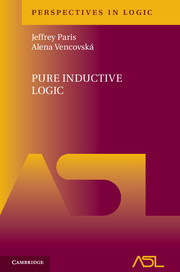Book contents
- Frontmatter
- Contents
- PREFACE
- Part 1 The Basics
- Part 2 Unary Pure Inductive Logic
- Part 3 Polyadic Pure Inductive Logic
- Chapter 24 Introduction to Polyadic Pure Inductive Logic
- Chapter 25 Polyadic Constant Exchangeability
- Chapter 26 Polyadic Regularity
- Chapter 27 Spectrum Exchangeability
- Chapter 28 Conformity
- Chapter 29 The Probability Functions up,L
- Chapter 30 The Homogeneous/Heterogeneous Divide
- Chapter 31 Representation Theorems for Sx
- Chapter 32 Language Invariance with Sx
- Chapter 33 Sx without Language Invariance
- Chapter 34 A General Representation Theorem for Sx
- Chapter 35 The Carnap-Stegmüller Principle
- Chapter 36 Instantial Relevance and Sx
- Chapter 37 Equality
- Chapter 38 The Polyadic Johnson's Sufficientness Postulate
- Chapter 39 Polyadic Symmetry
- Chapter 40 Similarity
- Chapter 41 PIP and Atom Exchangeability
- Chapter 42 The Functions
- Chapter 43 Less Well Travelled Roads
- BIBLIOGRAPHY
- Index
- Symbols and Abbreviations
Chapter 24 - Introduction to Polyadic Pure Inductive Logic
from Part 3 - Polyadic Pure Inductive Logic
Published online by Cambridge University Press: 05 May 2015
- Frontmatter
- Contents
- PREFACE
- Part 1 The Basics
- Part 2 Unary Pure Inductive Logic
- Part 3 Polyadic Pure Inductive Logic
- Chapter 24 Introduction to Polyadic Pure Inductive Logic
- Chapter 25 Polyadic Constant Exchangeability
- Chapter 26 Polyadic Regularity
- Chapter 27 Spectrum Exchangeability
- Chapter 28 Conformity
- Chapter 29 The Probability Functions up,L
- Chapter 30 The Homogeneous/Heterogeneous Divide
- Chapter 31 Representation Theorems for Sx
- Chapter 32 Language Invariance with Sx
- Chapter 33 Sx without Language Invariance
- Chapter 34 A General Representation Theorem for Sx
- Chapter 35 The Carnap-Stegmüller Principle
- Chapter 36 Instantial Relevance and Sx
- Chapter 37 Equality
- Chapter 38 The Polyadic Johnson's Sufficientness Postulate
- Chapter 39 Polyadic Symmetry
- Chapter 40 Similarity
- Chapter 41 PIP and Atom Exchangeability
- Chapter 42 The Functions
- Chapter 43 Less Well Travelled Roads
- BIBLIOGRAPHY
- Index
- Symbols and Abbreviations
Summary
In Part 1 we placed no conditions on the arity of the relation symbols in L, the restriction to unary only happened in Part 2. In this third part we shall again allow into our language binary, ternary etc. relation symbols. As we have seen, despite the logical simplicity of unary languages, for example every formula becomes equivalent to a boolean combination of Π1 and Σ1 formulae, Unary PIL has still a rather rich theory. For this reason it is hardly surprising that with very few exceptions (for example Gaifman [30], Gaifman & Snir [32], Scott & Krauss [132], Krauss [69], Hilpinen [46] and Hoover [52]) ‘Inductive Logic’ meant ‘Unary Inductive Logic’ up to the end of the 20th century.
Of course there was an awareness of this further challenge, Carnap [12, p123 -4] and Kemeny [61], [64] both made this point. There were at least two other reasons why the move to the polyadic was so delayed. The first is that simple, everyday examples of induction with non-unary relations are rather scarce. However they do exist and we do seem to have some intuitions about them. For example suppose that you are planting an orchard and you read that apples of variety A are good pollinators and apples of variety B are readily pollinated. Then you might expect that if you plant an A apple next to a B apple you will be rewarded with an abundant harvest, at least from the latter tree. In this case one might conclude that you had applied some sort of polyadic induction to reach this conclusion, and that may be it has a logical structure worthy of further investigation.
Having said that it is still far from clear what probability functions should be proposed here (and possibly this is a third reason for the delay).
- Type
- Chapter
- Information
- Pure Inductive Logic , pp. 181 - 182Publisher: Cambridge University PressPrint publication year: 2015



